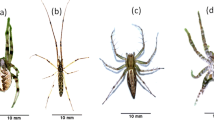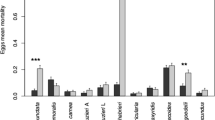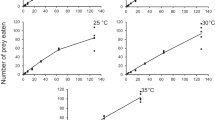Summary
A sight-count method for evaluation of predation by spiders on the green rice leafhopper,Nephotettix cincticeps was proposed and its applicability was tested under natural conditions.
The number (n) of leafhoppers preyed on by spiders per rice hill per day was estimated by the formula:
whereF is the frequency of predation observed per hill:P is given by dividing the time spent feeding on prey by 24 hours; andC refers to the total amount of feeding activity expressed in terms of the activity during the standard time interval. The total number (N) of prey attacked during the specified period can be given as follows:
With this method, the role of paddy-inhabiting spiders,Lycosa pseudoannulata, Oedothorax insecticeps, Tetragnatha spp, andEnoplognatha japonica, as predator ofN. cincticeps was evaluated with reference to life tables of the prey.
The advantages and limitation of the sight-count method were discussed as compared with other methods so far proposed.
Similar content being viewed by others
References
Baldwin, W. F., H. G. James andH. E. Welch (1955) A study of predators of mosquito larvae and pupae with a radio-active tracer.Can. Ent.83: 350–356.
Brooke, M. M. andH. O. Proske (1946) Precipitin test for determining natural insect predators of immature mosquitoes.J. Nat. Malaria Soc.5: 45–56.
DeBach, P. (1955) Validity of the insecticidal check method as a measure of the effectiveness of natural enemies of diaspine scale insects.J. econ. Ent.48: 584–588.
Dempster, J. P. (1960) A quantitative study of the predators on the eggs and larvae of the broom beetle,Phytodecta olivaceaForster, using the precipitin test.J. Anim. Ecol.29: 149–167.
Dempster, J. P. (1964) The feeding habits of the Miridae (Heteroptera) living on broom (Sarothamnus scoparius (L.)Wimm.)Ent. exp. appl.7: 149–154.
Downe, A. E. R. andA. S. West (1954) Progress in the use of the precipitin test in entomological studies.Can. Ent.86: 181–184.
Fleschner, C. A. (1958) Field approach to population studies of Tetranychid mites on citrus and avocado in California.Proc. 10th Int. Congr. Ent.2, 1956 (1958): 669–674.
Hall, R. R., A. E. R. Downe, C. R. MacLellan andA. S. West (1953) Evaluation of insect predatorprey relationships by precipitin test studies.Mosq. News13: 199–204.
Huffaker, C. B., M. van de Vrie andJ. A. McMurtry (1970) Ecology of Tetranychid mites and their natural enemies: a review II. Tetranychid populations and their possible control by predators: an evaluation.Hilgardia40 (11): 391–458.
Huffaker, C. B., C. E. Kennett, B. Matsumoto andE. G. White (1968) Some parameters in the role of enemies in the natural control of insect abundance (T. R. E. Southwood, ed.). London:Symposia Royal Ent. Soc.4: 59–75.
Itô, Y., K. Miyashita andK. Sekiguchi (1962) Studies on the predation of the rice crop insect pests using the insecticidal check method.Jap. J. Ecol.12: 1–11.
Itô, Y. andK. Miyashita (1968) Biology ofHyphantria cuneaDrury (Lepidoptera: Arctiidae) in Japan V. Preliminary life tables and mortality data in urban areas.Res. Popul. Ecol.10: 177–209.
Jenkins, D. W. andC. C. Hassett (1950) Radioisotopes in entomology.Nucleonics6 (3): 5–14.
Kajak, A. (1967) Productivity of some populations of web spiders.Secondary productivity of terrestrial ecosystems (K. Petrusewicz ed.). Warszawa, 1967: 807–820.
Kawahara, S., K. Kiritani andT. Sasaba (1971) The selective activity of rice-pest insecticides against the green rice leafhopper and spiders. (In Japanese with English summary).Botyu-Kagaku36: 121–128.
Kiritani, K., N. Hokyo, T. Sasaba andF. Nakasuji (1970) Studies on population dynamics of the green rice leafhopperNephotettix cincticepsUhler: Regulatory mechanism of the population density.Res. Popul. Ecol.12: 137–153.
Kiritani, K., S. Kawahara, T. Sasaba andF. Nakasuji (1971) An attempt of rice pest control by integration of pesticides and natural enemies.Gensei22: 19–23. (In Japanese with English summary).
Kobayashi, T. (1961) The effect of insecticidal applications to the rice stem borer on the leafhopper population.Special Rep. on Prediction of Pests, Ministry of Agric. & Forestry, No. 3, 126 pp. (In Japanese with English summary).
Loughton, B. G. andA. S. West (1962) Serological assessment of spider predation on the spruce budworm,Christoneura fumiferana (Cl. EM.) (Lepidoptera: Tortricidae).Proc. ent. Soc. Ont.92: 176–180.
Miyashita, K. (1963) Outbreaks and population fluctuation of insects, with special reference to agricultural insect pests in Japan.Bull. Nat. Inst. Agr. Sci. Ser. C., No. 15, 170pp.
Morris, R. F. (1963) The dynamics of epidemic spruce budworm populations (R. E. Morris ed.).Mem. ent. Soc. Can.31, 332pp.
Neilson, M. M. andR. F. Morris (1964) The regulation of European spruce sawfly numbers in the maritime provinces of Canada from 1937 to 1963.Can. Ent.96: 773–784.
Putman W. L. (1967) Prevalence of spiders and their importance as predators in Ontalio peach orchards.Can. Ent.99: 160–170.
Sandness, J. N. andJ. A. McMurtry (1970) Functional response of three species of phytoseiidae (Acarina) to prey density.Can. Ent.102: 692–704.
Southwood, T. R. E. (1966)Ecological methods with particular reference to the study of insect populations. Methuen & Co. Ltd. London, 391pp.
Stortenbeker, C. W. (1967) Observations on the population dynamics of the red locust,Nomadacris septemfasciata (Serville), in its outbreak areas.ITBON Mededel. No.84. 118pp.
Varley, G. C. andG. R. Gradwell (1963) The interpretation of insect population changes.Proc. Ceylon. Assoc. Adv. Sci.18: 142–156.
Author information
Authors and Affiliations
Rights and permissions
About this article
Cite this article
Kiritani, K., Kawahara, S., Sasaba, T. et al. Quantitative evaluation of predation by spiders on the green rice leafhopper,Nephotettix cincticeps Uhler, by a sight-count method. Res Popul Ecol 13, 187–200 (1972). https://doi.org/10.1007/BF02521977
Issue Date:
DOI: https://doi.org/10.1007/BF02521977




